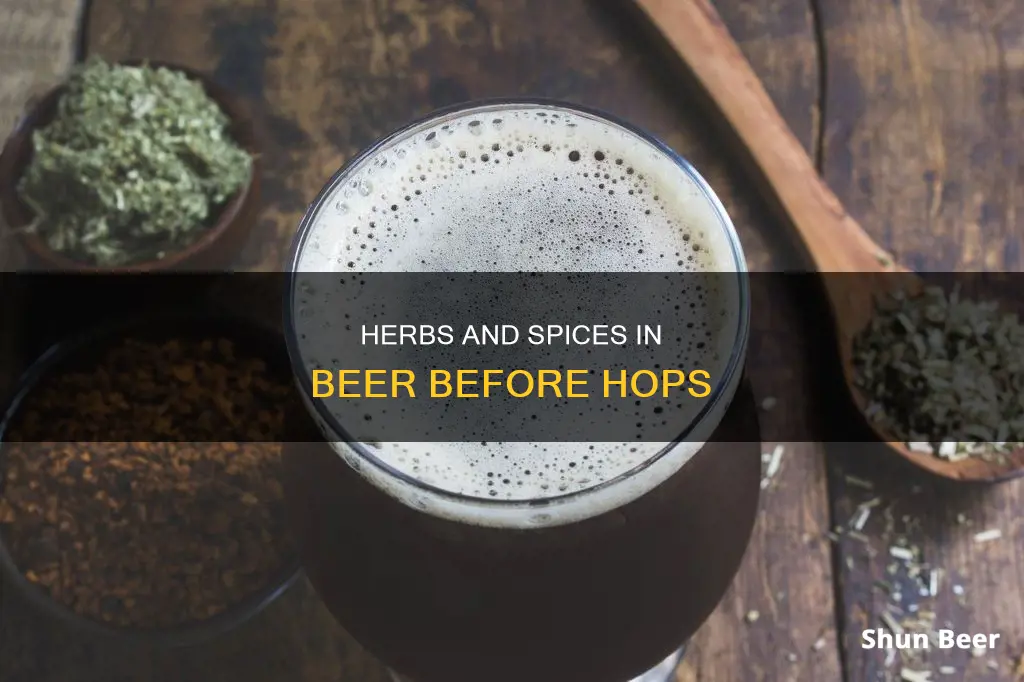
Before hops, beer was flavoured with a herb mixture known as gruit. Gruit was used to enhance the flavour of beers and was popular before the extensive use of hops. The earliest reference to gruit dates back to the late 10th century. Gruit recipes were often kept secret and passed down in families or guarded by monasteries. The specific blend of herbs used in gruit ales varied, but commonly included yarrow, sweet gale, mugwort, sage, rosemary, and bog myrtle.
| Characteristics | Values |
|---|---|
| Name | Gruit or Grout |
| Description | A blend of herbs used for bittering and flavouring beer |
| Time Period | Renaissance times and before |
| Main Ingredients | Myrica gale (bog myrtle), yarrow, and wild rosemary |
| Other Ingredients | Juniper berries, ginger, caraway seed, aniseed, nutmeg, cinnamon, mugwort, sweet gale, dandelion roots, oak bark, nettle, ground ivy, sage, heather, wormwood, etc. |
| Effect | Highly intoxicating, aphrodisiacal, psychotropic, narcotic |
| Monopoly | Held by the Church and local authorities |
What You'll Learn

Gruit, a herb mixture used before hops
Gruit (pronounced /ˈɡraɪt/; alternately grut or gruyt) is a herb mixture used for bittering and flavouring beer. The term originates from an area now in the Netherlands, Belgium, and northwestern Germany. Gruit was popular before the extensive use of hops and the earliest reference to it dates back to the late 10th century.
Gruit recipes were often kept secret and passed down in families or guarded by monasteries. Each gruit producer included different herbs, such as common heather, ground ivy, horehound, mugwort, sweet gale, and yarrow, to create unique flavours and effects. Other adjunct herbs used in gruit include juniper berries, ginger, caraway seed, aniseed, nutmeg, cinnamon, mint, and occasionally hops.
Gruit was widely used in the Middle Ages and was mandatory in beer during this period. It fell out of style and was largely replaced by hops in the 14th and 15th centuries due to several factors. Hops were cheaper, more effective at preserving beer, and had sedative properties that made them popular among working people and the rapidly growing English navy in the 16th and 17th centuries.
The switch from gruit to hops also coincided with historical events such as the Protestant Reformation, the Industrial Revolution, and the temperance movement, which contributed to the decline of gruit ales and the rise of hopped beers.
Blue Moon Beer: Hops or No Hops?
You may want to see also

Yarrow, a common ingredient in ancient beers
Yarrow, or Achillea millefolium, is a common ingredient in ancient beers. This inconspicuous, hardy, and versatile herb has been used in brewing, food, and medicine for thousands of years. Yarrow is native to Europe but has been widely naturalized in the New World and can be found all over the Northern Hemisphere.
Yarrow is one of the three main herbs most often referenced in Gruit recipes, along with Sweet Gale (Myrica gale) and Marsh Rosemary (Ledum palustre). Gruit is a herb mixture used for bittering and flavouring beer, popular before the extensive use of hops. The specific blend of herbs used in Gruit varied, but the inclusion of yarrow added bitterness and helped to balance the ale. Yarrow also has antibacterial, antiseptic, and antimicrobial properties, which could help protect the beer from infection and extend its shelf life.
Yarrow has a long history of human use, with the oldest recorded use dating back 60,000 years to the Neanderthals. It is also mentioned in ancient texts such as the Iliad, where it is said that Achilles used the plant to staunch the wounds of his men during the Trojan War. Yarrow's medicinal properties are well-known, and it has been used to treat wounds, fevers, indigestion, urinary tract infections, and dysentery, among other ailments.
The importance of yarrow in ancient brewing is further evidenced by the many names for the plant in different languages and cultures, particularly in Scandinavia. The most widely used name was "jordhumle," or "earth hop," which indicates its use as a substitute for hops in brewing. Other names referencing brewing or hops include "brygger" or "brewer" in Jutland, and "vallhumall" or "meadow hops" in Iceland.
Yarrow is still used today by some craft brewers who are interested in exploring ancient beer styles and ingredients. Beers made with yarrow can have a bright, perfume-like aroma and flavour, similar to chamomile or lemon balm. While not all drinkers may enjoy the taste of yarrow beer, it offers a window into the past and connects us to our history of brewing.
The Art of Single-Hop Beer: Simplicity and Flavor
You may want to see also

Bog myrtle, another popular ingredient
Bog myrtle, also known as sweet gale, or by its scientific name, Myrica gale, was a key ingredient in the unhopped ales of medieval Europe. It grows in marshlands and swampy lowlands at the edges of lakes, ponds, and rivers in the northern latitudes of Europe, Canada, the United States (particularly in the northernmost areas), and Alaska.
Bog myrtle has played a significant role in the history of brewing in Britain, Ireland, Europe, and even modern-day Scandinavia, where it is called "Pors". It is believed that the Vikings used this plant in their beer-making process, much like how hops are used today.
The flowering shrub was a primary element of gruit, a herb mixture used for flavouring and preserving beer before the common use of hops. Gruit recipes were often closely guarded secrets, and brewers would sometimes add other herbs of their choice to create unique flavours and effects. Bog myrtle was one of the best-known ingredients in medieval gruit, along with mugwort and yarrow.
Bog myrtle imparts a somewhat astringent and resinous flavour and mouthfeel to beer. It can be used as a partial hop substitute or as an herbal additive, either during the boil or in the fermenter. The interaction with alcohol helps to better integrate its overall effect.
Today, bog myrtle continues to be used by homebrewers and small traditional craft brewers in the areas where it is found. Some modern breweries, such as Treboom Brewery in North Yorkshire, England, and TRVE Brewing in Denver, have experimented with making beers infused with bog myrtle, keeping the ancient tradition alive.
The Historical Addition of Hops to Beer
You may want to see also

Sahti, a traditional Finnish beer style
Sahti is a traditional Finnish beer style and is recognised as one of the oldest continuously brewed beer styles in the world. It is a type of farmhouse ale, first brewed by peasants in the 1500s, and is made from malted and unmalted grains, including barley and rye.
Sahti is traditionally flavoured with juniper, which imparts a resiny character and serves as a preservative. The beer is also flavoured with wild yeast and bacteria, giving it a signature tartness. The end product is a cloudy, unfiltered beer with a distinct taste similar to bananas, balanced by the bitterness from the juniper branches.
The brewing process for Sahti has not changed much over the last 500 years. It is traditionally brewed using a long step infusion mash that can last up to six hours, after which the wort is lautered through a kuurna, a trough-shaped tun. The beer is then fermented with bakers' yeast, which creates a cloudy appearance and an abundance of sediment.
Commercial versions of Sahti are now available, usually with an ABV of around 8%. However, due to the higher percentage of alcohol, it is only sold in commercial breweries, pubs, or state-owned Alko stores in Finland and must be stored cold until consumption.
The Art of Describing Beer Hops
You may want to see also

Purl, a wormwood-flavoured beer
Purl, also known as wormwood ale, is an English drink that was popular in the early 19th century, especially among labourers who drank it in the early hours of the morning. It is made by infusing ale with the tops of various species of Artemisia ("wormwood"), particularly Artemisia maritima, or "sea wormwood", which grows in coastal salt marshes.
Other bitter herbs such as orange peel, senna, gentian root, calamus aromaticus, and snake root might also be added to the brew. Purl was mentioned by Shakespeare in his play, The Merry Wives of Windsor, and featured in Charles Dickens's novel, The Old Curiosity Shop.
By the middle of the 19th century, the use of wormwood in purl had been largely forgotten, and the recipe changed to mulling ale with gin, sugar, and spices such as ginger. This new version of the drink was sold by purl-men from purl-boats on the Thames and was popular for a time before being replaced by beer, specifically the variety known as "bitter".
Purl-royal was a similar drink made using wine instead of ale or beer.
Malt-Forward Beer Styles: Exploring Hop-Free Brewing
You may want to see also
Frequently asked questions
Before hops, beer was flavoured with a herb mixture called gruit. Gruit was used to enhance the flavour of beers and commonly included herbs such as common heather, ground ivy, horehound, mugwort, sweet gale, and yarrow.
Gruit is a blend of herbs that brewers would add to beer before the widespread use of hops. The specific blend of herbs used in gruit beer varied and was often kept secret.
Gruit fell out of style due to an anti-gruit campaign that fed off the anti-clerical and anti-pleasure hysteria of the Protestant Reformation. The fact that gruit blends in many parts of northern Europe were exclusive monopolies of the Church also contributed to the decline of gruit beer.







